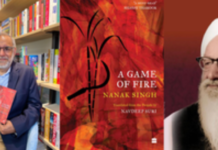BY SURESH JINDAL
New Delhi– “Words. Sounds. Images: A History of Indian Media & Entertainment” by Amit Khanna is a tour de force that is encyclopaedic in the vastness of its canvas.
It is now a required volume on the bookshelves of scholars, researchers and aficionados of Indian cinema.
The essay in the book on the history of literature, music, dance and other entertainment arts is breath taking and shows polymath with an insatiable hunger for knowledge, a keen intelligence and a mind capable of absorbing enormous amount of data.
I have known Amit from my beginning days in the industry which he had entered shortly before I came to it to produce my first film “Ranigandha”. I have been witness to his creative restlessness as he engaged himself with media in all forms – films, TV, music and print His accomplishments and achievements are enviable.
The sincerity of his friendship, kindness and helpfulness to all are such that no one
grudges him his accomplishments. In an industry, like in all arts fields, that has its
rivalries, camps and jealousies, Amit is one of the rare persons I have met who never speaks ill of another.
Through his working with two legends of the industry, Dev Anand and G.P. Sippy, and decades of leadership in the Film Federation of India and Producers Guild, he has been uniquely positioned to experience it from its core.
This, of course, is in addition to his own creativity of being an Award winning producer and Director and the writer of some of the most memorable lyrics of cinema. By his investing all he had, his overnight entry into starting the first private video channels was truly heroic.
There are books on cinema that write about a single aspect of it – actors, directors, music etc. This volume is unique in that it integrates all fields of creative media.
Not only does it succeed splendidly but does so in a highly absorbing manner with the highest levels of erudition and scholarship. It entertains and enlightens in a rare pageantry and enriching panorama into the history of drama, dance, music, poetry, puppetry of our civilization.
The only caveat I have is to his repetition of the discredited Colonial-Racial Aryan Invasion/Migration Theory. Studies in multi disciplinary fields have proven it to be false.
The DNA analysis of the skeletons at Rakhigarhi and excavations at Keeladi in Tamil Nadu are further nails in its coffin. The latest are reports from Max Planck Institute geneticists discovery of south Indians having migrated to Australia 4,000 years ago, which can be read here https://www.nationalgeographic.com.au/australia/four-thousand-years-ago-indians-landed-in-australia.aspx
The book has a valuable documentation of the landmark films of Indian cinema in all its various languages along with the creators like producers, directors, actor, music directors, playback singers and lyricists, making it one of the most valuable reference books on cinema which cannot be improved upon till date.
The book has no foot notes and index, which initially I found very irritating. Because like all egotists and self cherishing beings I first wanted to know if my name and those of my “classic” films are referenced in it or not.
But compelled to wade through it to assuage my ego many gems and treasures of information absorbed and pleased my attention that I otherwise would have given just a cursory glance that made me glad the book was san index and foot notes.
For at 952 pages with its rich information and documentation it does present a daunting challenge to even the most voracious reader and has to be savoured in leisurely steps to be fully enriched by its multiple vistas.














